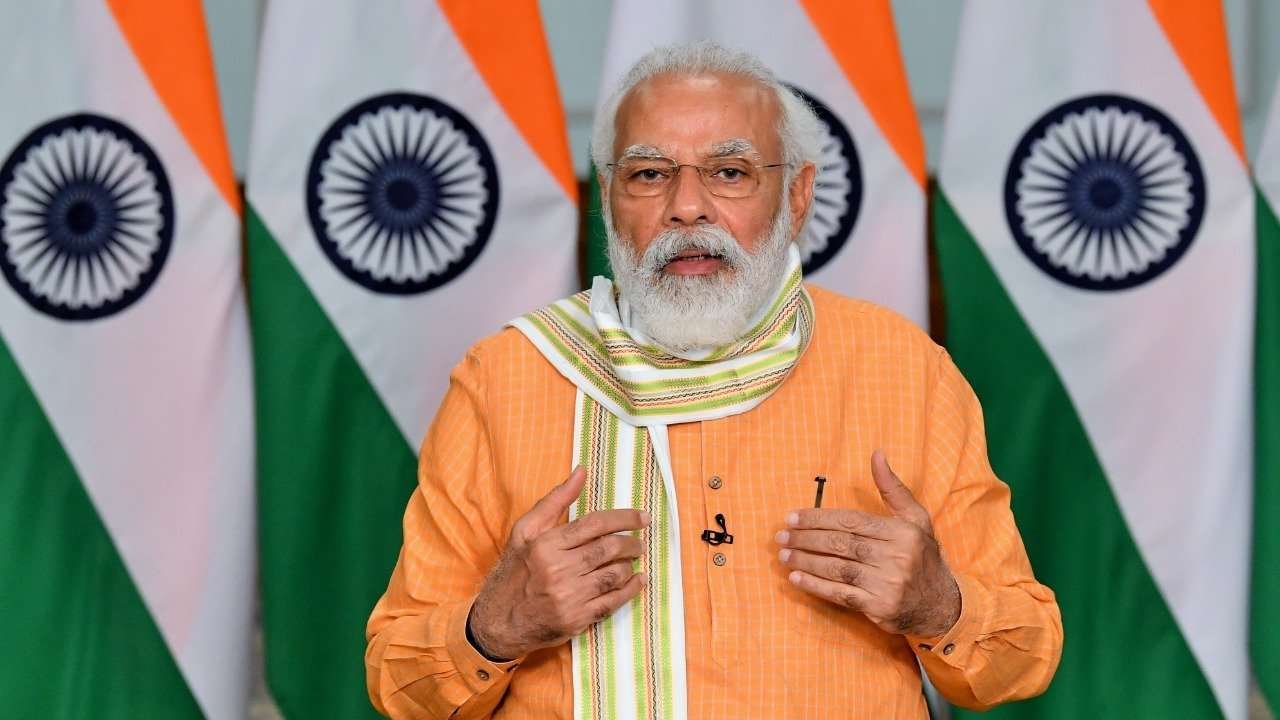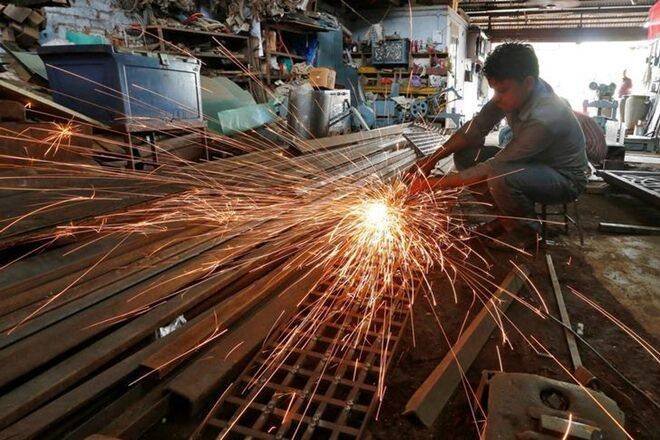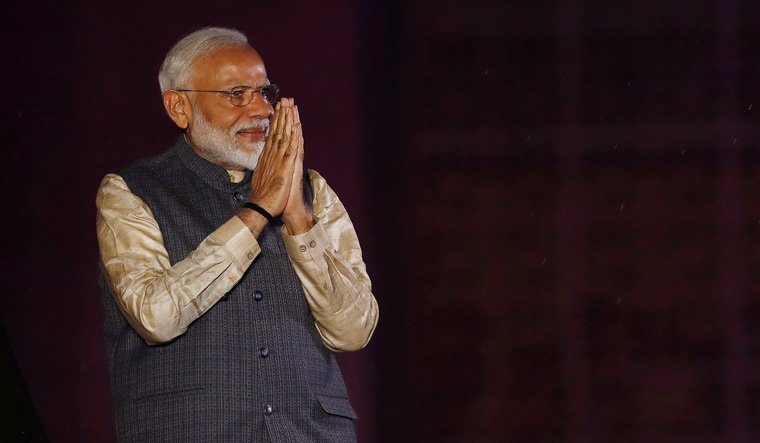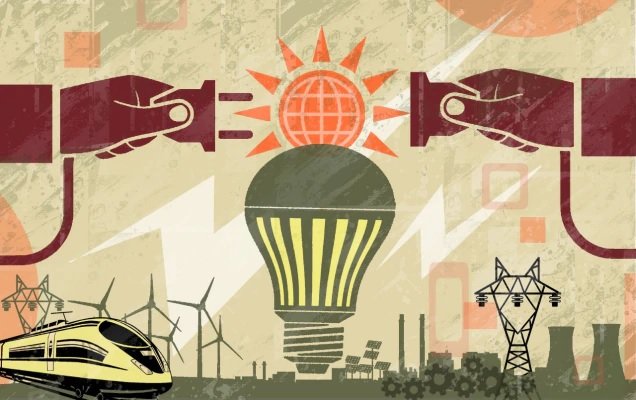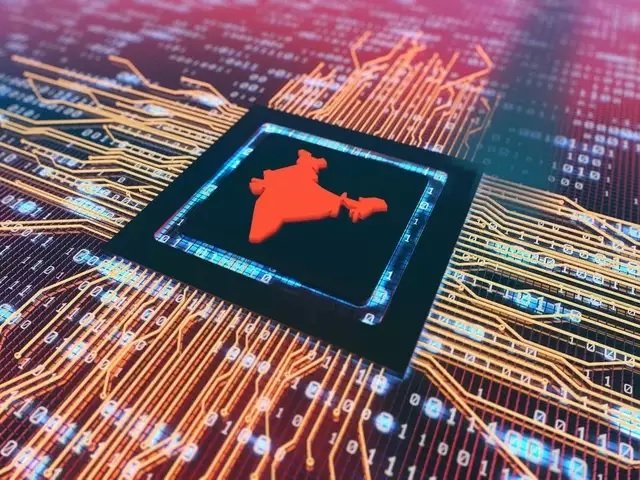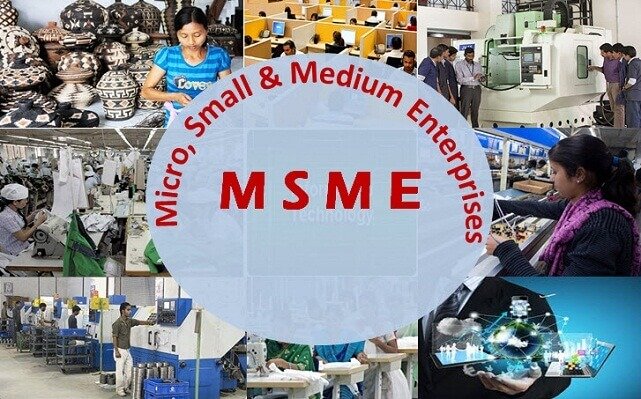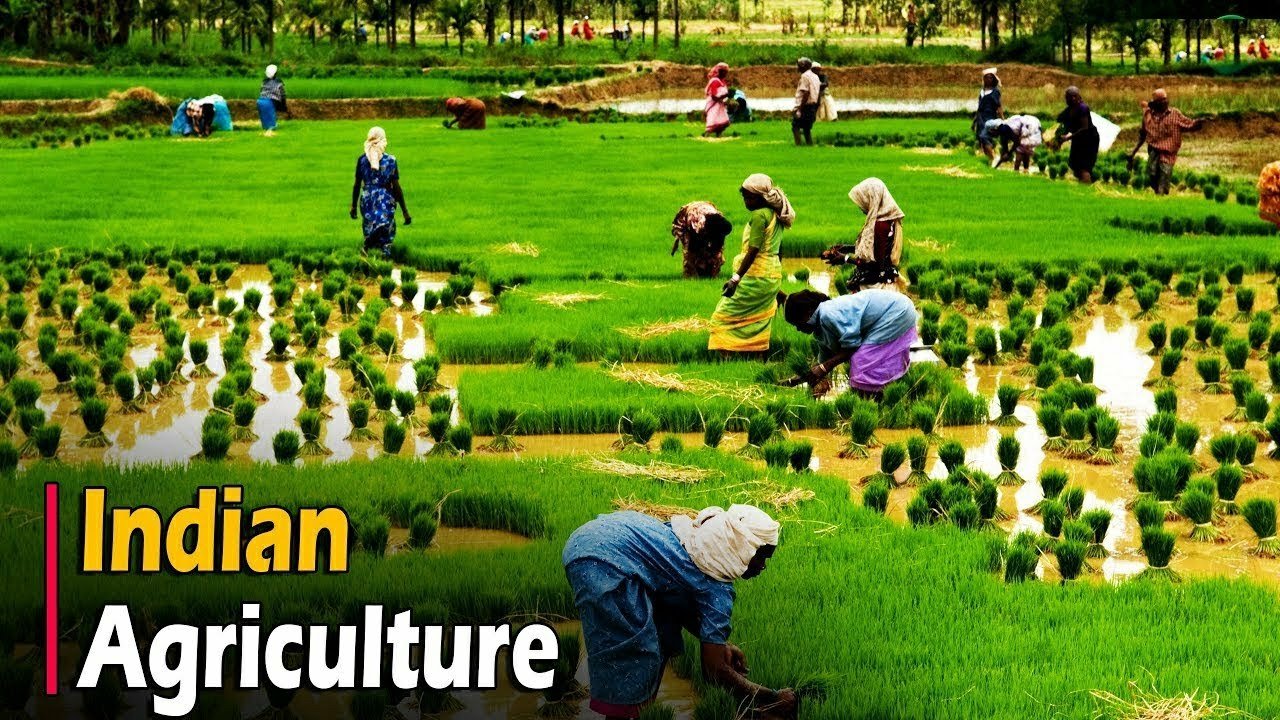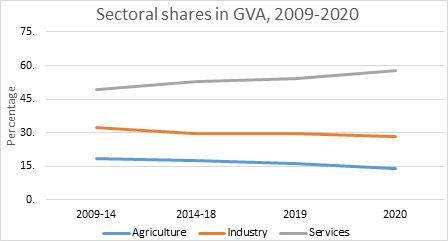Keeping the fundamental principle of Antyodaya in mind, the Modi government enthused technological advancement in all the policies and programs and ensured leakage-free delivery for all in general and marginalised in particular. The governance framework prepared by Prime Minister Narendra Modi has paid well during the pandemic that has emerged as a primary battleground in his second term.
“The voters in this country did not care about Congress schemes. Very few benefitted from the schemes of Congress governments. This time they got gas cylinder and Rs 1.5 lakh for house. We were looking for the evidence to the contrary but we could not find it. We even peaked inside houses and found gas cylinders. The government gave funds through Direct Benefit Transfer (DBT). They used JAM trinity – Jan Dhan, Aadhar and Mobile. Initially, I thought that MUDRA loans are rubbish and fake but I have recorded videos. Shobha Lal, sitting 50 km away from Azamgarh, is a Dalit who got Rs 50,000 as MUDRA loan. I came back and checked the MUDRA loan data where 4.81 crore people had got loans and Rs 2.1 lakh crore had been dispersed. This is a big change. This is a big governance exercise.”[i]
These were the views shard by senior journalist Shekhar Gupta during a program after the election results were announced in 2019, where he recounted the reasons for BJP’s victory. This was a programme where panelists and audience members were not supporters of Prime Minister Narendra Modi; however, at this point, even they could not deny the glaring reality.
In the 2019 general election, Narendra Modi again formed government with even more votes and seats than before. He had promised a transparent, accountable and corruption-free government at the Centre in 2014 and he hadfulfilled most of his promises over the next five years. As a result, people showed even more faith in him and the BJP won 303 seats and 38% votes. There were more than 200 Lok Sabha seats that the BJP won with more than 50% votes.[ii]
Now, Modi government has completed seven years at the Centre and the personal popularity of Prime Minister Narendra Modi has only increased in these many years-even during the time of pandemic.[iii] The framework designed by the government in the initial years is now reaping benefits for common people. The governance principles of the Modi government have been clear since the day one in office. On one side, he was inspired by the ideology of Antyodaya propounded by the Jana Sangh ideologue and founder, Deen Dayal Upadhyay, and on the other hand, he enthused technology to ensure delivery with minimum leakage and pilferage. While doing so, his government never forgot unhindered and easy delivery to those who have been unattended since long and have been waiting at the end of the queue.
This is politics of ‘welfare of all’ where governance and justice enthused with technology are an integral part of the core agenda of Modi government. Any individual or political party wanting to win elections, now has to come up with certain policies, proposals and programs that directly target and benefit the people. These are different from the perfunctory face saving schemes of the past as any schemes now are spoken of in terms of deliverables, deadlines and achievements. The blanket and vague slogan of ‘Garibi Hatao’ (Eradicate Poverty) does not work anymore; people expect political aspirants to provide effective solutions with visible benefits for the last women standing in the line. The schemes are also not bureaucratic tools anymore; they have a political face and hence answerability. With an outcome based approach entering politics under Modi government, the discourse around politics of welfare and governance seems to have completed a full circle. Under this approach, there is no negation of foreign investment, or profit making by the corporates but at the same time the revenue earned by the state has to be utilised for the vulnerable, poor and downtrodden without any leakage and pilferage to bridge the socio-economic divide in the country.
As the Chief Minister of Gujarat for 13 years and then as the Prime Minister of India, Narendra Modi has directed his efforts at bridging the socio-economic divide through the intervention of state policies and people’s participation. The objective of his policies is always clear in terms of people it aims to reach. It naturally follows then that the impact is huge and closely monitored implementation leads to time-bound deliveries. He wrote in a letter to the people of India after the completion of one year of Modi 2.0, “The people of the country voted for a substantial transformation. The nation saw how the administrative apparatus broke itself free of status quo and from the swamp of corruption as well as mis-governance. True to the spirit of ‘Antyodaya’ the lives of millions have been transformed.”[iv]
Given the size of the Indian populace, each of Modi’s schemes takes a comprehensive approach where every aspect of application is considered. The policies are clear about targets, benefits, and how these will reach where intended. The policies are designed in a way that there is minimum leakage and pilferage. The focus remains on the skill, scale, and speed for any program, policy, or campaign. The ‘Welfare of All’ approach under Prime Minister Modi has seen three key aspects: use of technology, corruption free government and Antyodaya.
Technology and Transparency
Technology has emerged as a great enabler in this process by delivering democracy and governance. For a country like India where democratic traditions are part of a vibrant cultural system, technology has become a crucial catalyst. Technology is today a partner in democracy in all these senses. It allows reach, access, dissent, diversity and justice. It has changed the face of governance through innovation and enhanced public participation and response. Long before Narendra Modi became the Prime Minister, he understood the power that technology could lend to implementation and governance. As the Chief Minister of Gujarat in 2013, he said during a Google chat show, “Internet is a game changer. Common citizens can now directly engage in policy making process. Internet has empowered people and made communication with leaders and the government a two-way process.”[v] After forming government in 2014, one of the mega campaigns launched by Modi was Digital India. It created awareness towards improved online infrastructure and electronic availability of services. With this, the country decisively stepped towards e-governance where the Information and Communication Technology (ICT) was used to deliver government services, exchange information, integrate systems and services and manage interactions within the government system. The aim of this campaign now is to connect rural areas with high-speed internet and create universal digital literacy.[vi]
JAM Trinity
In the development and governance sector, the government has turned to the technological trinity of Jan Dhan-Aadhar-Mobile (J-A-M) to make the system more effective, accountable and transparent. The biggest single achievement of this trinity has been cutting out middlemen, and gradually putting more than 350 schemes from 51 ministries into the Direct Benefit Transfer (DBT) programme which saved Rs 1.70 lakh crore while disbursing Rs 13 lakh crore in the first six years of the government.[vii] These three factors have worked in tandem to ensure ease of operation. The absence of one would have led to the failure of other, hence their appearance as a trinity. First, Jan Dhan accounts ensured financial inclusion of the entire population. Then Aadhaar number brought in a secure identification system to prevent misuse, duplication or pilferage. Mobile phones further completed the circle of online and mobile transactions and verification.
Jan Dhan is now the world’s biggest program of financial inclusion. It was launched on 28 August 2014. More than 42 crore bank accounts have been opened by April 2021 under Jan Dhan scheme where a balance of 147,000 crore is there in beneficiary accounts with the help of 1.26 lakh Bank Mitras delivering branchless banking services in Sub-Service Areas.[viii] Today, people don’t have to run from pillar to post to get scholarships, pensions, subsidies, MNREGA payment, funds for housing or toilets. Once approved, these funds, subsidies or scholarships directly reach the account of the beneficiaries.
Government E-Market
While JAM is sweeping in its reach and impact, several other systemic changes were also introduced to incorporate technology. Take for example, the Govt E-Market or GEM. GEM is a dedicated e-market tool for goods and services procured by government organisations, departments and public sector units. It uses technology to automate procurement processes and systems, introducing greater accountability in public procurement. A small entrepreneur can now register on the Government e-Marketplace (GEM), and bid competitively for supply of goods to the Government. As he expands his business, he also contributes to lowering the cost of procurement for the government. This leads to increased efficiency and greater value for public money. The platform has a network of around 13 lakh sellers and service providers. The cumulative transaction value of goods and services procured from GeM by state and central government organisations grew from Rs 51,200 crore a year ago to Rs 1.1 lakh crore by the end of March 2021. [ix]
Corruption-free Government
A prerequisite to the ‘welfare of all’ approach is corruption-free government. Elimination of corruption is also the cornerstone for Antyodaya as the benefits meant for the last person in the queue cannot possibly reach her in a corrupt system. Here also, technology assumes a key role. The recent advancement of technology is not only because of its benefits in terms of enhanced output but also because it assures a system that is not vulnerable to human corruption. It provides transparency and adherence to a pre-approved set of rules with no exceptions. The extensive use of technology for governance in the last seven years has reaped rich dividends.
Over the span of seven years, there was not a single case of political corruption against the Modi government. It seems we have come a long way since the time of former Prime Minister Rajiv Gandhi, who had said that out of every single rupee sent by the Centre, only 15 paise reaches at the village level. When corruption takes place, the pilferage and leakage eats into the funds meant for the poor. Understanding this, the Narendra Modi government tried to minimise pilferage and leakage of funds at different level by using different technological tools. Today, various weaker and vulnerable sections are getting benefits of this technological disruption in welfare schemes, policies and programs.
Geo-tagging
The practice of geo-tagging is an example of how technology has been used to check corrupt practices. Modi government started monitoring important schemes through apps and dashboards in which posting of geo-tagged pictures of the beneficiaries or the work done by the ground-level government official became mandatory. This was not a small change; a geo-tagged picture shows the date and time of the picture apart from the picture of the beneficiary or the work done. It takes just seven clicks on your computer to find rural development projects, including the names and details of the projects or the individual beneficiaries, right up to the village level. For example, on the AwaasApp one can find out how many houses have been built say in Andaman and Nicobar under Pradhan Mantri Aawas Yojana with details and pictures of the beneficiaries with their new homes.[x] There is a proof of every home and toilet made under the scheme. This has helped put a stop to pilferage of government money in the name of bogus work. Now, the said assets have to be imaged, geotagged and digitally documented, deterring corrupt practices and ensuring optimum utilisation of funds.
Social Justice and Governance
Politics can be understood as authoritative allocation of values. The existence of such practices for a substantive time results in a just society taking shape and politics becoming a tool of social transformation. On the other hand, take a simple definition of justice – treat equal equally, unequal unequally. When we club both the definitions of politics and justice, then the idea of social justice begins to emerge. Justice can be understood at two levels – procedural and distributive. Governments normally focus on distributive justice when policies and programs are framed for the public. They don’t think how these will reach people in different parts of the country living in vastly different conditions. The result is leakage and pilferage at different levels. Hence, considering procedural justice along with distributive justice becomes a prerequisite for the success of any scheme or policy. In the last 7 years, Modi government ensured that both distributive and procedural justice come into play. Schemes were designed to ensure people’s participation and maximum benefit.
This government is totally aware and committed for the upliftment of poor, vulnerable and excluded and introduced many policies ensuring affirmative action in different ways. Since independence, reservation in jobs was considered as the only way of affirmative action which was very much required and if the task was accomplished with full sincerity then the scenario might have been different today. Modi government is ensuring backlog vacancies to be filled on one hand and on the other coming up with many innovative ways of ensuring affirmative action. Today when millions of youth are passing out from higher eduction institutions every year so this is not possible to give job to everyone. Modi government has created an ecosystem for entrepreneurship for everyone especially the weaker section. The government has redefined the whole idea which is now – Political change to economic change and development to social change.
We have always considered caste as the parameter for backwardness and formulated program and policies. Modi government is continuing with this but also serving new parameters for empowerment of vulnerable, weak and backwards. In one of his new approach Prime Minister Modi has taken district as the centre. If the district would be backward and disconnected, then every individual living in that area would be backward in comparison with others. So, 115 districts of the country have been identified which are most backwards and they are now named as aspirational districts.[xi] A new roadmap for their overall development is being prepared. Finally, Modi government has tried to connect governance with social justice and ensured welfare of all in the society.
Modi government ensured leakage proof disbursal of benefits through technology. Many schemes had been in existence before, but due to bad governance, funds were under-utilised, un-utilised or misdirected. Under the transformed set up, the list of beneficiaries includes people from all walks of life – farmers to pensioners and students to businessmen. For example, the Dalit Venture Capitalist Fund was set up to boost entrepreneurship among the scheduled castes. Under the Stand Up Scheme, loans up to Rs 1 crore were given to the youth of the community.[xii]
Under the Prime Minister Micro Units Development Refinance Agency (MUDRA), Dalits, Backwards and EBC are being given preference, and 62% beneficiaries are from these communities. Earlier, the scholarship of Dalit and backward students was either not disbursed or there was a delay. The HRD Ministry has given total fee concession to the Dalit, Tribal and Divyang students and all students whose annual income is less than one lakh. The numbers of National Fellowship for the students of OBC community has increased multifold. 100% increase has been done in the construction of hostels for OBC students. The number of beneficiaries under Dr Ambedkar Educational loan for OBC students has been increased. Stringent SC-ST Act to stop atrocities against Dalits has been formulated and Constitutional status to National Commission for Backward Classes was given in 2019. New policy for senior citizens was announced where the changing socio-economic concerns were kept in mind. As the numbers of senior citizens are increasing so the funds have been increased upto 80% for their welfare schemes. For the first time in the history of independent India, nomadic tribes were taken into policy framework and a new Board has been set up. Hostels for nomadic tribes were started in the name of Bharat Ratna Nanaji Deshmukh. Another target group where no one paid enough attention before was the disabled. Prime Minister brought them in focus and called them Divyanags. Social Justice Ministry has organised more than 2000 programs and 100 mega camps of artificial limbs, hearing aid and tricycle distribution.
Women have been at the forefront of nearly all of Modi’s schemes ever since 2014. Nearly 8 crore women living below poverty line got benefits of Ujjwala scheme that provided gas cylinder for cooking. Under the Sukanya Samridhi Yojana, small deposits supported by the Government of India were made for female children. The campaign Beti Padhao, Beti Bachao had a successful run on social media to improve the sex ratio and social condition of women. A cash incentive of Rs 6,000 was given to pregnant mothers and more than 50 lakh women are getting benefitted every year from this scheme. Maternity leave was also extended up to six months for working women.
Another major beneficiary group has been of farmers. The PM Irrigation scheme, PM Crop Insurance Scheme, PM Kisan Samman Nidhi where 6000 Rs every year was given to every Kisan. Earlier, this scheme was for farmers who had cultivated land below two acres, but it was extended to all the farmers after Narendra Modi won election for the second time. The recent farms reforms are being opposed by some rich farmers but these will only help the farmer community in increasing their income. The Prime Minister has also started Ayushman Bharat scheme which is the world’s largest health insurance scheme under which 50 crore people have been provided a cover of up to 5 lakhs. More than 10 crore are now registered and 1.77 crore have been admitted under this scheme.[xiii]
Tackling the Pandemic
The second term of Modi government kick started with the resolve of taking a great leap forward and making India a 5-trillion economy. Besides effectively continuing the schemes of the first term, Modi government also took many landmark decisions that are bound to have a positive impact in long run. Among these watershed moments was the abolition of Triple Talaq and revocation of Article 370 in Jammu and Kashmir in August 2019. A new pension scheme was announced for traders and shopkeepers helping 3 crore people. Ushering the next phase of Swachch Bharat Abhiyan, the Prime Minister started a campaign to make India plastic free by 2022. More than 90 lakhs houses were sanctioned under the Pradhan Mantri Awas Yojana Urban. E-gram Swaraj and Swamitva Yojana was launched by the Prime Minister to give a push growth in villages. But in March 2020, the government was forced to announce a lockdown to save lives in the wake of the deadly Covid-19 virus. Following this, various quick steps were taken by the Modi government to protect life and living of common people. Under the Vande Bharat mission, 28,000 Indians stuck abroad were brought back to the country. The government set up robust health infrastructure for Covid-19 that saved life of millions of people. The fatality rate in India was the lowest in the world. Union government launched ‘Aarogya Setu’ app to facilitate easy tracking of the risk of the virus. Lockdown announced by the Modi government reduced the intensity of Covid-19 spread by more than 60%. India became second biggest producer of PPE kits and N95 masks in the world where the production was almost zero in February 2020.
After assessing the problems faced by fellow countrymen, the Modi government announced an economic package of Rs 20 lakh crore and gave a bold call for Aatmanirbhar Bharat Abhiyan (Self-reliant India). He outlined five pillars for this – Economy, Infrastructure, Technology, System, Demand. Massive relief package of Rs 3 lakh crore was allocated for the MSME sector. Key measures for strengthening agricultural infrastructure logistics, capacity building, governance and administrative reforms for agriculture, fisheries and food processing sectors were announced. Infrastructure reforms in eight sectors – coal, defence, rural development, corporate, finance, public health, public sector enterprises and business were also announced. Just after the announcement of the lockdown by the Prime Minister, a relief package of Rs 1.70 lakh crore was announced to give instant help to the distressed people belonging to marginalised sections of the society. It was ensured that 80 crore poor get 5 kg wheat or rice and 1 kg pulses for free for the next few months. MGNREGA wages were increased from Rs 182 to Rs 202 per day which benefited 13.62 crore families.
In the midst of the raging pandemic, the Modi government has completed its second year. The pandemic, however, shows no sign of receding. In this scenario, besides the continuation of pro-poor pro-marginalised schemes, the government has come up with a vaccine which is in the market now and more than 13 crore people had already been vaccinated by April 2021.[xiv]As the second wave of virus broke across the country, the government opened the vaccination program for all above the age of 18 years, making the Indian vaccination drive the largest in the world.
In the two years of its second term, the Modi government has safely navigated the Indian ship through difficult seas. The challenge that has presented itself in the form of Coronavirus is not a small one. It has affected all corners of the world and has managed to destabilise countries and their projections. In India, the government has managed to steer a very large population through this unforgiving virus, and in this sense, its achievement is tremendous. Modi government has taken care of those who needed it the most. The future, however, is not clear yet as further mutations and waves of the virus are expected. The journey hence is expected to be long and arduous. In the coming months, the government will not only have to further safeguard the life of its citizens but also restore their livelihoods that have been inevitably affected by the pandemic. The government will once again have to kick-start the economy and put it on the right track, while remaining cautious of the ever-changing virus and its vagaries. Given the past record of Prime Minister Narendra Modi and projections by the international agencies, it seems India will overcome these uncertain times.
(Author Brief Bio: Dr Swadesh Singh teaches Political Science in Satyawati College of Delhi University)
References
About The Aspirational Districts Programme http://niti.gov.in/about-aspirational-districts-programme (Accessed on 6 April, 2021)
Covid-19 vaccination: How is India’s inoculation drive going https://www.bbc.com/news/world-asia-india-56345591 (Accessed on 20 April, 2021)
Ghidiyal, Subodh, Centre plans 1,000 Dalit startups over 3 years https://timesofindia.indiatimes.com/business/india-business/centre-plans-1000-dalit-startups-over-3-years/articleshow/78341975.cms (Accessed on 10 April, 2021)
Gupta, Shekhar, ‘How India Voted: Making Sense of the 2019 General Election’ https://www.youtube.com/watch?v=hwnnn1M-T5U (Accessed on 1 April, 2021)
How 351 Modi Government Schemes Saved 1.70 Lakh Crore https://economictimes.indiatimes.com/news/economy/policy/how-351-modi-government-schemes-saved-rs-1-70-lakh-crore/articleshow/78954779.cms?from=mdr (Accessed on 3 April, 2021)
India Today Mood of the Nation Survey January 2021 https://www.indiatoday.in/mood-of-the-nation-survey-2021 (Accessed on 2 April, 2021)
Internet is the Game-changer in Today’s World: Modi at Google Conference https://www.firstpost.com/tech/news-analysis/internet-is-the-game-changer-in-todays-world-modi-at-google-conference-2-3622227.html (Accessed on 2 April, 2021)
Mahurkar, Uday (2017) ‘Marching With a Billion: Analysing Narendra Modi’s Government at Midterm’, Penguin Viking: Gurgaon
Mahurkar, Uday,‘Drones, geo-tagging, big data: Narendra Modi’s governance is tech-friendly’ https://www.indiatoday.in/magazine/from-india-today-magazine/story/20170814-narendra-modi-technology-government-monitor-rural-development-1027731-2017-08-04 (Accessed on 5 April. 2021)
Narayan, Badri (2021) ‘Republic of Hindutva: How the Sangh is Reshaping Indian Democracy’, Penguin Viking: Gurgaon
Pandey, Devesh, ’50% vote share for BJP in 200 seats’ https://www.thehindu.com/elections/lok-sabha-2019/50-vote-share-for-bjp-in-200-seats/article27226514.ece (Accessed on 1 April, 2021)
Pradhan Mantri Jan Dhan Yojana https://pmjdy.gov.in/ (Accesses on 18 April, 2021)
Prime Minister Narendra Modi’s letter to the people of India: A year after the start of his second term in office https://economictimes.indiatimes.com/news/politics-and-nation/pm-modis-letter-to-the-people-of-india-a-year-after-the-start-of-his-second-term-in-office/articleshow/76098495.cms?from=mdr (Accessed on 2 April, 2021)
Prime Minister Jan Arogya Yojana https://pmjay.gov.in/ (Accessed on 20 April, 2021)
Public procurement from GeM portal crosses Rs 1 lakh cr: CEO Talleen Kumar https://economictimes.indiatimes.com/news/economy/finance/public-procurement-from-gem-portal-crosses-rs-1-lakh-cr-ceo-talleen-kumar/articleshow/81733835.cms?utm_source=contentofinterest&utm_medium=text&utm_campaign=cppst (Accessed on 5 April, 2021)
Sahasrabuddhe, Vinay, Dheeraj Nayyar (2018) ‘The Innovation Republic: Governance Innovations in India Under Narendra Modi’, Wisdom Tree: New Delhi
Sharma, Amit, ‘Digital India: Making Village ‘Smart’ https://telecom.economictimes.indiatimes.com/tele-talk/digital-india-making-villages-smart/719 (Accessed on 2 April, 2021)
Singh, Shri Prakash (2016) ‘Politics for a New India: A Nationalistic Perspective’, Rupa Publications: New Delhi
[i]Shekhar Gupta, ‘How India Voted: Making Sense of the 2019 General Election’ https://www.youtube.com/watch?v=hwnnn1M-T5U (Accessed on 1 April, 2021)
[ii]Devesh Pandey, ’50% vote share for BJP in 200 seats’ https://www.thehindu.com/elections/lok-sabha-2019/50-vote-share-for-bjp-in-200-seats/article27226514.ece (Accessed on 1 April, 2021)
[iii]India Today Mood of the Nation Survey January 2021 https://www.indiatoday.in/mood-of-the-nation-survey-2021 (Accessed on 2 April, 2021)
[iv]Prime Minister Narendra Modi’s letter to the people of India: A year after the start of his second term in office https://economictimes.indiatimes.com/news/politics-and-nation/pm-modis-letter-to-the-people-of-india-a-year-after-the-start-of-his-second-term-in-office/articleshow/76098495.cms?from=mdr (Accessed on 2 April, 2021)
[v]Internet is the Game-changer in Today’s World: Modi at Google Conference https://www.firstpost.com/tech/news-analysis/internet-is-the-game-changer-in-todays-world-modi-at-google-conference-2-3622227.html (Accessed on 2 April, 2021)
[vi]Amit Sharma, Digital India: Making Village ‘Smart’ https://telecom.economictimes.indiatimes.com/tele-talk/digital-india-making-villages-smart/719 (Accessed on 2 April, 2021)
[vii]How 351 Modi Government Schemes Saved 1.70 Lakh Crore https://economictimes.indiatimes.com/news/economy/policy/how-351-modi-government-schemes-saved-rs-1-70-lakh-crore/articleshow/78954779.cms?from=mdr (Accessed on 3 April, 2021)
[viii]Pradhan Mantri Jan Dhan Yojana https://pmjdy.gov.in/ (Accesses on 18 April, 2021)
[ix]Public procurement from GeM portal crosses Rs 1 lakh cr: CEO Talleen Kumar https://economictimes.indiatimes.com/news/economy/finance/public-procurement-from-gem-portal-crosses-rs-1-lakh-cr-ceo-talleen-kumar/articleshow/81733835.cms?utm_source=contentofinterest&utm_medium=text&utm_campaign=cppst (Accessed on 5 April, 2021)
[x] Uday Mahurkar, ‘Drones, geo-tagging, big data: Narendra Modi’s governance is tech-friendly’ https://www.indiatoday.in/magazine/from-india-today-magazine/story/20170814-narendra-modi-technology-government-monitor-rural-development-1027731-2017-08-04 (Accessed on 5 April. 2021)
[xi]About The Aspirational Districts Programme http://niti.gov.in/about-aspirational-districts-programme (Accessed on 6 April, 2021)
[xii]Subodh Ghidiyal, Centre plans 1,000 Dalit startups over 3 years https://timesofindia.indiatimes.com/business/india-business/centre-plans-1000-dalit-startups-over-3-years/articleshow/78341975.cms (Accessed on 10 April, 2021)
[xiii]Prime Minister Jan Arogya Yojana https://pmjay.gov.in/ (Accessed on 20 April, 2021)
[xiv]Covid-19 vaccination: How is India’s inoculation drive going https://www.bbc.com/news/world-asia-india-56345591 (Accessed on 20 April, 2021)

